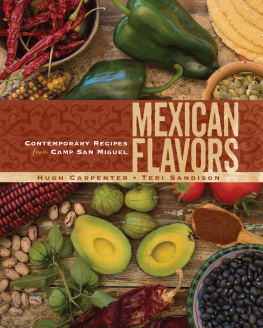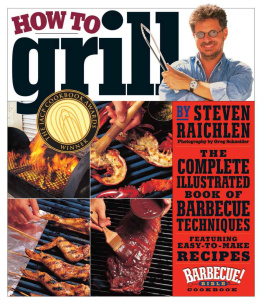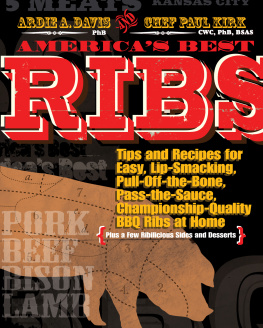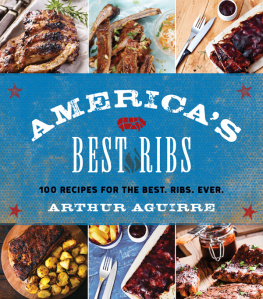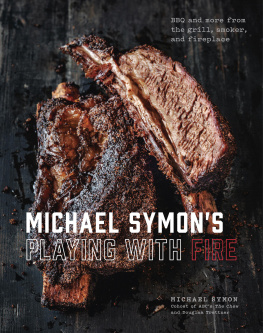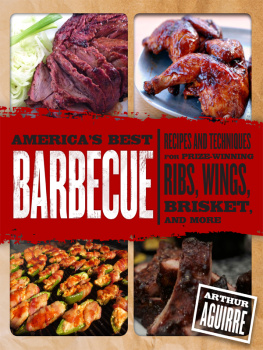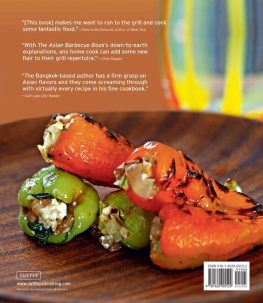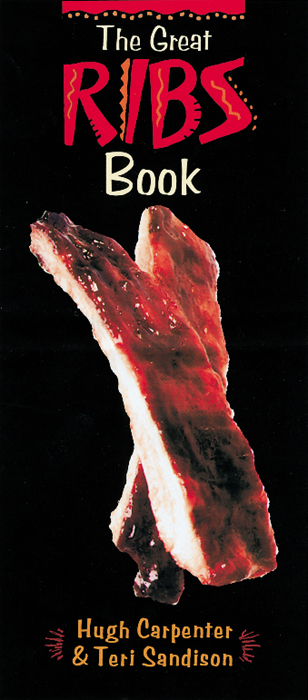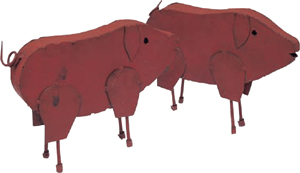
Copyright 1999 by Hugh Carpenter and Teri Sandison
Photographs copyright 1999 by Teri Sandison
All rights reserved.
Published in the United States by Ten Speed Press, an imprint of the Crown Publishing Group, a division of Random House, Inc., New York.
www.crownpublishing.com
www.tenspeed.com
Ten Speed Press and the Ten Speed Press colophon are registered trademarks of Random House, Inc.
Library of Congress Cataloging-in-Publication Data on file with the publisher.
eISBN: 978-1-60774-459-7
Cover by Beverly Wilson
v3.1
T o family and friends
united around a feast of ribs.


Contents
Introduction
R ib lovers are everywhere. Many of us remember ribs from childhood, mounded on platters at family picnics, roadside rib shacks, and church suppers. And every rib connoisseur knows an ideal cooking method, a secret blend of seasonings, a type of hardwood chips that generates the perfect smoky aroma, and where to find the best rib joint in the area.
This book is for rib connoisseurs. But its also for the occasional backyard cook and for first-time cooks ready to begin a lifetime of pleasure cooking ribs.
Few other smells are as welcoming as the smell of ribs slowly cooking on the grill, roasting in the oven, or bubbling in a delectable sauce. Youll find that dinner guests move without invitation toward the cooking ribs, and usually wont stop eating ribs until just a pile of bones remains. Sharing a platter of ribs is a great way to reaffirm old friendships or to get new ones off to a great start.
The following recipes take only minutes to prepare. Most of the rubs and marinades can be made days in advance. Except for an occasional ethnic product, all the ingredients are available at most supermarkets. Or, if you are pressed for time, follow the fail-safe cooking instructions outlined in , and use a commercial barbecue sauce.
When cooking these recipes, remember that low and slow is best. Rib meat is tough. It requires low heat and long cooking to break down the meat fiber, render the fat, and make the meat succulent and tender.
Every recipe specifies a type of rib, but feel free to substitute your favorite. All the common varieties are described in the next section. Our personal preference, whether smoking, grilling, roasting, or simmering ribs in liquid, is the king of ribs, pork baby back ribs.
All the recipes in this book yield enough for the ribs to be served as entres for four. They can also be served as appetizers for six to ten, or you can double or triple them to serve larger groups. When serving ribs as an entre, accompany them with other simple dishes such as garden salads, an easy side dish like garlic bread or roasted potatoes, and for dessert, ice creams, cobblers, and pies.
We hope you have the same pleasure cooking and serving these ribs as we have had creating these recipes at our home. Gather your family and friends, open some icy drinks, cook generous amounts of ribs, and enjoy the pleasure of all those gathered as they relish one of the worlds most satisfying foods.
Hugh Carpenter and Teri Sandison
Spareribs
T he word spareribs always refers to ribs from pigs (the word is never used for beef or lamb) and, specifically, to the side or underbelly of the pig. Most markets sell these sides or slabs with the fatty, cartilage brisket end that runs across the top quarter of each side of spareribs. Ask the butcher to trim off the brisket end or complete this as shown in the photograph. We freeze these scraps and add them to the pot when making chicken stock.
The flap of meat that extends partway across the side of ribs is called the skirt. Most ribs sold in supermarkets will have the skirt removedthese are sometimes called St. Louisstyle ribs. Ribs with the skirt left onKansas Citystyleare more often bought fresh from a butcher. Whether or not to remove the skirt is a matter of personal preference. When cooked, it will become as tender as the rest of the meat. Spareribs are great smoked, grilled, roasted, or braised.
Serving portion:
As an appetizer, 2 ribs per person. As an entre, side of ribs per person.
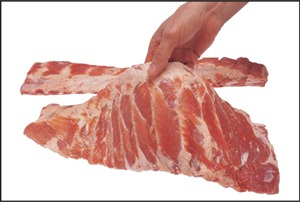
Kansas CityStyle
St. LouisStyle
Pork Baby Back Ribs
C ut from the loin or back section, pork baby back ribs are the Rolls-Royce of ribs. With more meat and less fat than most ribs, baby backs are great smoked, grilled, roasted, or braised. Just a few years ago, pork baby back ribs were mostly sold by Asian markets, but now they are available at many supermarkets. Since the quality ranges from frozen ribs with little meat to fresh pork baby back ribs containing plenty of succulent loin meat, check with rib aficionados and local butchers to find who sells the best ribs. A meaty side of pork baby back ribs should weight at least 1.9 pounds.
Serving portion:
As an appetizer, 2 ribs per person. As an entre, at least half a side per person.
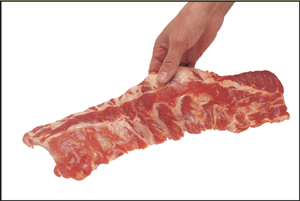
The King of Ribs
Country-Style Spareribs
T hese are meaty pieces from the rib end of the pork loin, and each piece contains a small bone. Boneless country-style spareribs are cut from the pork butt. These ribs are excellent smoked, grilled, roasted, or braised. Before cooking, always trim off all exterior fat.
Serving portion:
As an appetizer, 1 piece per person. As an entre, half a pound per person if the ribs are boneless, or slightly more if they contain the bone.
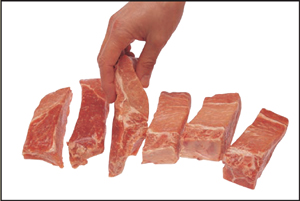
BONELESS
Beef Back Ribs
I ts fun to refer to these beef back ribs as dinosaur bones, because its impossible to display them or, for that matter, to eat them in a refined manner. From slabs cut from the loin and containing five or six bones, these ribs taste best smoked (our favorite way to cook them), grilled, or roasted. Because beef back ribs have so little meat, they are not as good as pork ribs when braised.
Serving portion:
As an appetizer, 2 ribs per person. As an entre, 6 ribs per person.



